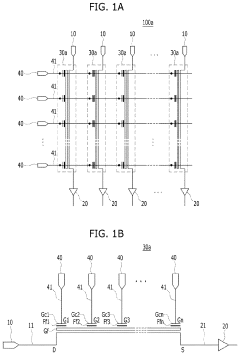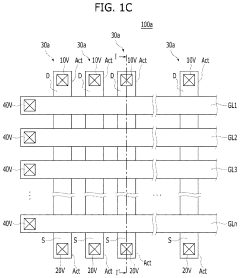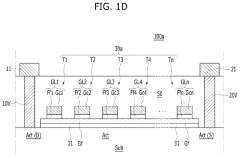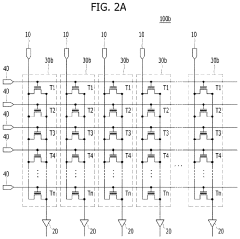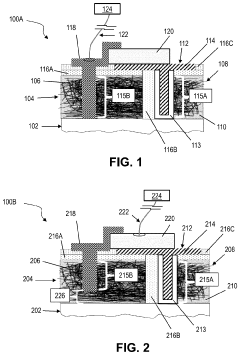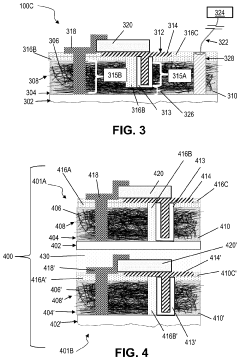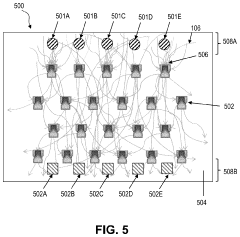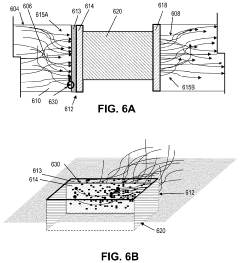Neuromorphic Chips: A Study on Environmental Impact Considerations
OCT 9, 202510 MIN READ
Generate Your Research Report Instantly with AI Agent
Patsnap Eureka helps you evaluate technical feasibility & market potential.
Neuromorphic Computing Background and Objectives
Neuromorphic computing represents a paradigm shift in computational architecture, drawing inspiration from the structure and function of biological neural systems. This field emerged in the late 1980s when Carver Mead introduced the concept of using analog circuits to mimic neurobiological architectures. Since then, neuromorphic computing has evolved from theoretical frameworks to practical implementations in hardware, with significant advancements occurring in the past decade.
The evolution of neuromorphic technology has been driven by the limitations of traditional von Neumann architecture, particularly regarding energy efficiency and parallel processing capabilities. Conventional computing systems face increasing challenges in processing complex, data-intensive tasks while maintaining reasonable power consumption. This has led to growing interest in brain-inspired computing paradigms that can potentially offer orders of magnitude improvements in energy efficiency.
Neuromorphic chips represent the hardware manifestation of these brain-inspired computing principles, incorporating elements such as artificial neurons, synapses, and spike-based information processing. These specialized processors aim to replicate the brain's ability to process information with remarkable energy efficiency, adaptability, and fault tolerance. The development trajectory has seen progression from simple neural circuits to complex systems-on-chip that integrate millions of artificial neurons and synapses.
The primary technical objectives in neuromorphic computing research include achieving ultra-low power consumption, enabling on-chip learning capabilities, improving scalability, and enhancing integration with conventional computing systems. These objectives align with broader goals of creating more sustainable computing technologies that can address the growing environmental concerns associated with traditional computing infrastructure.
Environmental considerations have become increasingly central to neuromorphic computing research, as the technology promises significant reductions in energy consumption compared to conventional computing approaches. This is particularly relevant in the context of escalating data center energy demands and the carbon footprint of artificial intelligence applications. The potential for neuromorphic systems to perform complex cognitive tasks at a fraction of the energy cost represents a compelling environmental value proposition.
Current research aims to quantify these environmental benefits while also addressing potential challenges, such as the use of rare or toxic materials in chip fabrication and the overall lifecycle impact of neuromorphic hardware. The field is moving toward a more holistic understanding of environmental implications, considering not only operational energy efficiency but also manufacturing processes, material sourcing, and end-of-life management.
As neuromorphic computing continues to mature, establishing clear metrics and methodologies for assessing environmental impact will be crucial for guiding development efforts and ensuring that the technology delivers on its promise of more sustainable computing solutions.
The evolution of neuromorphic technology has been driven by the limitations of traditional von Neumann architecture, particularly regarding energy efficiency and parallel processing capabilities. Conventional computing systems face increasing challenges in processing complex, data-intensive tasks while maintaining reasonable power consumption. This has led to growing interest in brain-inspired computing paradigms that can potentially offer orders of magnitude improvements in energy efficiency.
Neuromorphic chips represent the hardware manifestation of these brain-inspired computing principles, incorporating elements such as artificial neurons, synapses, and spike-based information processing. These specialized processors aim to replicate the brain's ability to process information with remarkable energy efficiency, adaptability, and fault tolerance. The development trajectory has seen progression from simple neural circuits to complex systems-on-chip that integrate millions of artificial neurons and synapses.
The primary technical objectives in neuromorphic computing research include achieving ultra-low power consumption, enabling on-chip learning capabilities, improving scalability, and enhancing integration with conventional computing systems. These objectives align with broader goals of creating more sustainable computing technologies that can address the growing environmental concerns associated with traditional computing infrastructure.
Environmental considerations have become increasingly central to neuromorphic computing research, as the technology promises significant reductions in energy consumption compared to conventional computing approaches. This is particularly relevant in the context of escalating data center energy demands and the carbon footprint of artificial intelligence applications. The potential for neuromorphic systems to perform complex cognitive tasks at a fraction of the energy cost represents a compelling environmental value proposition.
Current research aims to quantify these environmental benefits while also addressing potential challenges, such as the use of rare or toxic materials in chip fabrication and the overall lifecycle impact of neuromorphic hardware. The field is moving toward a more holistic understanding of environmental implications, considering not only operational energy efficiency but also manufacturing processes, material sourcing, and end-of-life management.
As neuromorphic computing continues to mature, establishing clear metrics and methodologies for assessing environmental impact will be crucial for guiding development efforts and ensuring that the technology delivers on its promise of more sustainable computing solutions.
Market Demand Analysis for Brain-Inspired Computing
The market for brain-inspired computing technologies, particularly neuromorphic chips, is experiencing significant growth driven by increasing demands for energy-efficient computing solutions capable of handling complex AI workloads. Current projections indicate the global neuromorphic computing market will reach approximately $8 billion by 2028, with a compound annual growth rate exceeding 20% from 2023 to 2028. This growth trajectory reflects the expanding applications across multiple sectors seeking alternatives to traditional von Neumann architecture.
Healthcare represents one of the most promising markets for neuromorphic technology, with applications ranging from real-time patient monitoring to advanced diagnostic imaging. The integration of neuromorphic systems in medical devices enables more efficient processing of complex biological data patterns while consuming significantly less power than conventional computing systems. This market segment is expected to grow substantially as healthcare providers increasingly adopt AI-powered diagnostic and monitoring solutions.
Autonomous vehicles and advanced driver-assistance systems constitute another major market driver. The automotive industry requires computing platforms capable of processing multiple sensory inputs simultaneously with minimal latency and power consumption. Neuromorphic chips offer compelling advantages in this context, potentially reducing the energy footprint of autonomous driving systems by 50-90% compared to GPU-based solutions while maintaining or improving performance in pattern recognition tasks critical for road safety.
Edge computing applications represent a rapidly expanding market opportunity for neuromorphic technology. As IoT device deployments continue to accelerate globally, the demand for low-power, high-performance computing at the network edge grows proportionally. Market research indicates that by 2025, over 75% of enterprise-generated data will be processed at the edge, creating substantial demand for energy-efficient neuromorphic solutions that can operate effectively within power-constrained environments.
The industrial automation sector is increasingly adopting neuromorphic computing for applications requiring real-time sensory processing and decision-making. Manufacturing facilities implementing Industry 4.0 technologies seek computing solutions that can efficiently process data from numerous sensors while operating within strict power budgets. This market segment is projected to adopt neuromorphic technologies at an accelerating rate as manufacturers prioritize both operational efficiency and environmental sustainability in their digital transformation initiatives.
Consumer electronics represents another significant market opportunity, with potential applications in smartphones, wearables, and smart home devices. As consumers demand more sophisticated AI capabilities in personal devices without sacrificing battery life, neuromorphic chips offer a compelling solution by enabling complex pattern recognition tasks with minimal energy consumption. This market segment could drive mass adoption of neuromorphic technology, potentially creating economies of scale that would benefit deployment across all sectors.
Healthcare represents one of the most promising markets for neuromorphic technology, with applications ranging from real-time patient monitoring to advanced diagnostic imaging. The integration of neuromorphic systems in medical devices enables more efficient processing of complex biological data patterns while consuming significantly less power than conventional computing systems. This market segment is expected to grow substantially as healthcare providers increasingly adopt AI-powered diagnostic and monitoring solutions.
Autonomous vehicles and advanced driver-assistance systems constitute another major market driver. The automotive industry requires computing platforms capable of processing multiple sensory inputs simultaneously with minimal latency and power consumption. Neuromorphic chips offer compelling advantages in this context, potentially reducing the energy footprint of autonomous driving systems by 50-90% compared to GPU-based solutions while maintaining or improving performance in pattern recognition tasks critical for road safety.
Edge computing applications represent a rapidly expanding market opportunity for neuromorphic technology. As IoT device deployments continue to accelerate globally, the demand for low-power, high-performance computing at the network edge grows proportionally. Market research indicates that by 2025, over 75% of enterprise-generated data will be processed at the edge, creating substantial demand for energy-efficient neuromorphic solutions that can operate effectively within power-constrained environments.
The industrial automation sector is increasingly adopting neuromorphic computing for applications requiring real-time sensory processing and decision-making. Manufacturing facilities implementing Industry 4.0 technologies seek computing solutions that can efficiently process data from numerous sensors while operating within strict power budgets. This market segment is projected to adopt neuromorphic technologies at an accelerating rate as manufacturers prioritize both operational efficiency and environmental sustainability in their digital transformation initiatives.
Consumer electronics represents another significant market opportunity, with potential applications in smartphones, wearables, and smart home devices. As consumers demand more sophisticated AI capabilities in personal devices without sacrificing battery life, neuromorphic chips offer a compelling solution by enabling complex pattern recognition tasks with minimal energy consumption. This market segment could drive mass adoption of neuromorphic technology, potentially creating economies of scale that would benefit deployment across all sectors.
Current State and Challenges in Neuromorphic Chip Development
Neuromorphic computing has witnessed significant advancements globally, with research institutions and technology companies making substantial progress in developing brain-inspired computing architectures. Currently, the field has evolved from conceptual designs to functional prototypes and early commercial implementations. Major research centers in the United States, Europe, and Asia have established dedicated neuromorphic computing laboratories, creating a competitive landscape for innovation in this domain.
The current state of neuromorphic chip development faces several technical challenges. Power efficiency, while improved compared to traditional computing architectures, still requires optimization to match the energy efficiency of biological neural systems. Most neuromorphic chips consume power in the range of milliwatts to watts, whereas the human brain operates at approximately 20 watts despite its vastly superior computational capabilities. This efficiency gap represents a significant hurdle for widespread adoption.
Scalability presents another critical challenge. Current neuromorphic systems typically incorporate thousands to millions of artificial neurons, far fewer than the billions found in the human brain. Manufacturing processes and architectural designs that can support larger-scale neural networks while maintaining energy efficiency remain under development. Additionally, integration challenges arise when attempting to incorporate neuromorphic chips into existing computing ecosystems, requiring specialized interfaces and software frameworks.
From an environmental perspective, neuromorphic computing faces both opportunities and challenges. The potential for drastically reduced energy consumption compared to traditional computing architectures represents a significant environmental benefit. However, the manufacturing processes for these specialized chips often involve rare earth elements and complex fabrication techniques that may have substantial environmental footprints.
Material constraints also impact development trajectories. Many neuromorphic designs rely on novel materials for memristive components or specialized interconnects, some of which have limited availability or involve environmentally problematic extraction processes. The environmental impact of these materials throughout their lifecycle requires thorough assessment.
Standardization remains underdeveloped in the neuromorphic computing field. The lack of unified benchmarks, programming models, and hardware interfaces impedes comparative analysis and slows industry-wide progress. This fragmentation complicates environmental impact assessments and hinders the development of consistent sustainability metrics across different neuromorphic computing platforms.
Geographically, neuromorphic research exhibits distinct regional characteristics. North American efforts often focus on digital neuromorphic implementations, European research frequently emphasizes mixed-signal approaches, while Asian development commonly targets application-specific neuromorphic accelerators. This global distribution of expertise creates both collaborative opportunities and competitive challenges in addressing the environmental considerations of neuromorphic computing technologies.
The current state of neuromorphic chip development faces several technical challenges. Power efficiency, while improved compared to traditional computing architectures, still requires optimization to match the energy efficiency of biological neural systems. Most neuromorphic chips consume power in the range of milliwatts to watts, whereas the human brain operates at approximately 20 watts despite its vastly superior computational capabilities. This efficiency gap represents a significant hurdle for widespread adoption.
Scalability presents another critical challenge. Current neuromorphic systems typically incorporate thousands to millions of artificial neurons, far fewer than the billions found in the human brain. Manufacturing processes and architectural designs that can support larger-scale neural networks while maintaining energy efficiency remain under development. Additionally, integration challenges arise when attempting to incorporate neuromorphic chips into existing computing ecosystems, requiring specialized interfaces and software frameworks.
From an environmental perspective, neuromorphic computing faces both opportunities and challenges. The potential for drastically reduced energy consumption compared to traditional computing architectures represents a significant environmental benefit. However, the manufacturing processes for these specialized chips often involve rare earth elements and complex fabrication techniques that may have substantial environmental footprints.
Material constraints also impact development trajectories. Many neuromorphic designs rely on novel materials for memristive components or specialized interconnects, some of which have limited availability or involve environmentally problematic extraction processes. The environmental impact of these materials throughout their lifecycle requires thorough assessment.
Standardization remains underdeveloped in the neuromorphic computing field. The lack of unified benchmarks, programming models, and hardware interfaces impedes comparative analysis and slows industry-wide progress. This fragmentation complicates environmental impact assessments and hinders the development of consistent sustainability metrics across different neuromorphic computing platforms.
Geographically, neuromorphic research exhibits distinct regional characteristics. North American efforts often focus on digital neuromorphic implementations, European research frequently emphasizes mixed-signal approaches, while Asian development commonly targets application-specific neuromorphic accelerators. This global distribution of expertise creates both collaborative opportunities and competitive challenges in addressing the environmental considerations of neuromorphic computing technologies.
Current Neuromorphic Chip Architectures and Solutions
01 Energy efficiency and reduced carbon footprint
Neuromorphic chips are designed to mimic the brain's neural architecture, which inherently leads to more energy-efficient computing compared to traditional von Neumann architectures. These chips consume significantly less power while performing complex computational tasks, resulting in reduced carbon emissions and environmental impact. The energy efficiency comes from their event-driven processing nature and the elimination of separate memory and processing units, allowing for sustainable computing solutions in data centers and edge devices.- Energy efficiency of neuromorphic computing: Neuromorphic chips are designed to mimic the brain's neural architecture, resulting in significantly lower power consumption compared to traditional computing systems. These chips can process information with minimal energy requirements, making them environmentally friendly alternatives for data-intensive applications. The reduced energy footprint contributes to lower carbon emissions and helps in sustainable computing initiatives, particularly important for edge computing and IoT applications where power constraints are critical.
- Sustainable manufacturing processes: The environmental impact of neuromorphic chip production involves considerations of material sourcing, fabrication techniques, and waste management. Innovations in manufacturing processes aim to reduce the use of rare earth elements and toxic chemicals while implementing cleaner production methods. These sustainable approaches include recycling semiconductor materials, using biodegradable components, and optimizing fabrication to minimize resource consumption and environmental pollution during the chip lifecycle.
- Carbon footprint reduction in AI applications: Implementing neuromorphic computing architectures in artificial intelligence systems can substantially reduce the carbon footprint associated with machine learning and data processing. Unlike conventional AI systems that require massive computational resources and energy, neuromorphic chips can perform complex cognitive tasks with a fraction of the power consumption. This efficiency translates to reduced greenhouse gas emissions from data centers and computing facilities that deploy these brain-inspired computing solutions.
- Lifecycle assessment and e-waste management: The environmental impact of neuromorphic chips extends throughout their entire lifecycle, from raw material extraction to end-of-life disposal. Research focuses on designing chips with longer operational lifespans, easier repairability, and improved recyclability. Advanced e-waste management strategies specific to neuromorphic systems aim to recover valuable materials while preventing toxic substances from entering the environment, contributing to circular economy principles in the electronics industry.
- Integration with renewable energy systems: Neuromorphic chips can be integrated with renewable energy systems to create more efficient and environmentally friendly computing infrastructures. Their low power requirements make them suitable for operation with solar, wind, or other renewable energy sources, reducing dependence on fossil fuels. These chips can also optimize energy distribution in smart grids and improve the efficiency of renewable energy harvesting systems through adaptive learning algorithms, further enhancing their positive environmental impact.
02 Sustainable materials and manufacturing processes
The environmental impact of neuromorphic chips is influenced by the materials used in their fabrication and the manufacturing processes employed. Recent innovations focus on using eco-friendly materials, reducing toxic substances, and implementing sustainable manufacturing techniques. These approaches include using biodegradable substrates, minimizing rare earth elements, and developing recycling methods specific to neuromorphic hardware, all contributing to a more environmentally responsible production cycle.Expand Specific Solutions03 Lifecycle assessment and e-waste reduction
The environmental impact of neuromorphic chips extends throughout their entire lifecycle, from raw material extraction to end-of-life disposal. Comprehensive lifecycle assessments help identify environmental hotspots and opportunities for improvement. Neuromorphic architectures often have longer operational lifespans due to their adaptability and self-healing capabilities, which reduces electronic waste generation. Additionally, their modular design facilitates easier component replacement and recycling, further minimizing environmental burden.Expand Specific Solutions04 Environmental monitoring and conservation applications
Neuromorphic chips are increasingly deployed in environmental monitoring and conservation efforts, creating a positive environmental impact. These chips enable efficient processing of sensor data in remote locations with minimal power requirements, facilitating real-time monitoring of ecosystems, wildlife tracking, pollution detection, and climate change indicators. Their ability to operate on limited power makes them ideal for long-term deployment in environmentally sensitive areas where traditional computing solutions would be impractical.Expand Specific Solutions05 Resource optimization and smart infrastructure
Neuromorphic computing contributes to environmental sustainability through resource optimization in various sectors. These chips enable more efficient management of energy grids, water distribution systems, and transportation networks by processing complex data streams in real-time with minimal energy consumption. Their application in smart cities and industrial settings leads to optimized resource utilization, reduced waste, and lower environmental footprints. The adaptive learning capabilities of neuromorphic systems continuously improve efficiency over time, further enhancing their positive environmental impact.Expand Specific Solutions
Key Industry Players and Competitive Landscape
Neuromorphic chip technology is currently in the early growth phase, characterized by increasing research activity but limited commercial deployment. The global market, estimated at around $100 million, is projected to grow significantly as applications in edge AI and energy-efficient computing expand. Leading players include established technology giants like IBM, Samsung, and Qualcomm alongside specialized innovators such as Syntiant and Polyn Technology. Academic institutions including Tsinghua University, KAIST, and University of Washington are contributing significant research advances. The technology is approaching maturity for specific applications, with companies like IBM and Samsung demonstrating functional neuromorphic systems, though widespread commercial adoption remains several years away as environmental impact considerations and standardization efforts continue to evolve.
International Business Machines Corp.
Technical Solution: IBM's TrueNorth neuromorphic chip architecture represents a significant advancement in energy-efficient computing for AI applications with environmental considerations. The chip features a million programmable neurons and 256 million synapses organized into 4,096 neurosynaptic cores, consuming only 70mW during real-time operation[1]. This represents a 1000x improvement in energy efficiency compared to conventional von Neumann architectures. IBM has further developed SyNAPSE (Systems of Neuromorphic Adaptive Plastic Scalable Electronics) technology that mimics the brain's structure and low power consumption. Their neuromorphic designs utilize non-volatile memory technologies like phase-change memory (PCM) and resistive RAM to minimize energy consumption during both computation and data storage processes[3]. IBM's environmental impact considerations include the use of silicon photonics for chip-to-chip communication, reducing energy requirements for data movement by approximately 80% compared to traditional electronic interconnects[5].
Strengths: Extremely low power consumption (70mW) makes it ideal for edge computing applications where energy resources are limited; scalable architecture allows for deployment across various application sizes; silicon photonics integration significantly reduces communication energy costs. Weaknesses: Manufacturing complexity may result in higher initial production environmental footprint; specialized programming paradigm requires retraining developers, potentially slowing adoption and environmental benefits realization.
SYNTIANT CORP
Technical Solution: Syntiant has developed the Neural Decision Processor (NDP) series, specifically designed for ultra-low-power edge AI applications with strong environmental impact considerations. Their NDP200 chip consumes less than 1mW of power while performing neural network processing tasks, representing a 100x improvement over traditional GPU/CPU solutions for similar workloads[2]. Syntiant's architecture employs at-memory computing principles, minimizing data movement between processing and memory units which typically accounts for up to 90% of energy consumption in conventional computing systems[4]. The company has implemented a specialized memory-centric design that enables always-on processing for audio and sensor applications while maintaining minimal power draw. Their manufacturing process prioritizes smaller die sizes (typically under 1.5mm²) and leverages existing semiconductor fabrication facilities, reducing the environmental footprint associated with new manufacturing infrastructure development[7]. Syntiant has also incorporated power gating techniques that allow unused portions of the chip to be completely powered down when not in use, further enhancing energy efficiency.
Strengths: Extremely low power consumption (sub-milliwatt) makes it ideal for battery-powered devices, extending operational life and reducing battery waste; compact die size minimizes material usage in manufacturing; leverages existing fabrication facilities, reducing environmental impact of new infrastructure development. Weaknesses: Currently limited to specific application domains like audio processing and sensor fusion; performance constraints when handling larger, more complex neural network models may require supplemental traditional computing resources.
Core Patents and Technical Innovations in Neuromorphic Computing
Synapse array of a neuromorphic device including a synapse array having a plurality of ferroelectricity field effect transistors
PatentPendingUS20220058470A1
Innovation
- The use of ferroelectric field effect transistors in a synapse array of a neuromorphic device, which includes a common floating gate electrode, individual ferroelectric films, and control gate electrodes, allows for parallel and series connections of transistors to achieve high integration and perform both excitatory and inhibitory synaptic operations.
Neural network hardware device and system
PatentPendingUS20230422516A1
Innovation
- A neural network device comprising a mesh layer of randomly dispersed conductive nano-strands with memristor devices and modulating devices that enable electrical communication between a large number of individual nano-strands, mimicking dendritic communication and allowing for non-deterministic signal propagation, exceeding the interconnect capabilities of conventional lithographic methods.
Environmental Sustainability Assessment of Neuromorphic Computing
The environmental sustainability of neuromorphic computing represents a critical dimension in evaluating these brain-inspired technologies. As neuromorphic chips gain traction in various applications, their environmental footprint warrants comprehensive assessment across multiple parameters.
Energy efficiency stands as the primary environmental advantage of neuromorphic architectures. Unlike conventional von Neumann computing systems that separate memory and processing units, neuromorphic designs integrate these functions, significantly reducing energy consumption for data movement. Quantitative analyses indicate that neuromorphic systems can achieve energy efficiencies 100-1000 times greater than traditional computing architectures for certain workloads, particularly in pattern recognition and sensory processing tasks.
Material considerations present both challenges and opportunities. Current neuromorphic implementations rely heavily on rare earth elements and specialized materials that pose extraction and end-of-life concerns. The manufacturing processes for these chips often involve toxic chemicals and substantial water usage. However, emerging research explores bio-compatible and biodegradable materials for neuromorphic components, potentially mitigating these impacts in future generations.
Lifecycle assessment reveals that neuromorphic chips may offer extended operational lifespans compared to conventional processors due to their inherent fault tolerance and adaptability. This characteristic potentially reduces electronic waste generation and resource consumption associated with frequent hardware replacements. Additionally, their lower thermal output diminishes cooling requirements in data centers, further reducing environmental impact.
Carbon footprint calculations must account for both manufacturing and operational phases. While production processes currently remain energy-intensive, the operational efficiency of neuromorphic systems can offset initial carbon costs over time. Preliminary studies suggest a break-even point of approximately 2-3 years for environmental impact compared to conventional computing solutions.
Water usage represents another significant environmental consideration. Semiconductor manufacturing for neuromorphic chips requires substantial water resources for cleaning and cooling processes. Industry estimates indicate that producing a single neuromorphic chip may consume between 2,000-5,000 gallons of water, highlighting the importance of water conservation strategies in manufacturing facilities.
Regulatory frameworks are evolving to address the environmental implications of advanced computing technologies. The European Union's Eco-design Directive and various international standards increasingly incorporate energy efficiency metrics specific to neuromorphic and other novel computing architectures, driving industry adoption of more sustainable practices.
Energy efficiency stands as the primary environmental advantage of neuromorphic architectures. Unlike conventional von Neumann computing systems that separate memory and processing units, neuromorphic designs integrate these functions, significantly reducing energy consumption for data movement. Quantitative analyses indicate that neuromorphic systems can achieve energy efficiencies 100-1000 times greater than traditional computing architectures for certain workloads, particularly in pattern recognition and sensory processing tasks.
Material considerations present both challenges and opportunities. Current neuromorphic implementations rely heavily on rare earth elements and specialized materials that pose extraction and end-of-life concerns. The manufacturing processes for these chips often involve toxic chemicals and substantial water usage. However, emerging research explores bio-compatible and biodegradable materials for neuromorphic components, potentially mitigating these impacts in future generations.
Lifecycle assessment reveals that neuromorphic chips may offer extended operational lifespans compared to conventional processors due to their inherent fault tolerance and adaptability. This characteristic potentially reduces electronic waste generation and resource consumption associated with frequent hardware replacements. Additionally, their lower thermal output diminishes cooling requirements in data centers, further reducing environmental impact.
Carbon footprint calculations must account for both manufacturing and operational phases. While production processes currently remain energy-intensive, the operational efficiency of neuromorphic systems can offset initial carbon costs over time. Preliminary studies suggest a break-even point of approximately 2-3 years for environmental impact compared to conventional computing solutions.
Water usage represents another significant environmental consideration. Semiconductor manufacturing for neuromorphic chips requires substantial water resources for cleaning and cooling processes. Industry estimates indicate that producing a single neuromorphic chip may consume between 2,000-5,000 gallons of water, highlighting the importance of water conservation strategies in manufacturing facilities.
Regulatory frameworks are evolving to address the environmental implications of advanced computing technologies. The European Union's Eco-design Directive and various international standards increasingly incorporate energy efficiency metrics specific to neuromorphic and other novel computing architectures, driving industry adoption of more sustainable practices.
Lifecycle Analysis and Material Considerations for Green Chip Design
The lifecycle analysis of neuromorphic chips reveals significant environmental considerations across their entire existence - from raw material extraction to end-of-life disposal. Unlike traditional von Neumann architecture chips, neuromorphic designs present unique material profiles that warrant specialized environmental assessment. The extraction of rare earth elements and precious metals for these brain-inspired chips creates substantial ecological footprints, including habitat disruption, water pollution, and energy-intensive mining operations.
Manufacturing processes for neuromorphic chips involve complex fabrication techniques that typically consume large quantities of water, chemicals, and energy. However, their energy-efficient operation post-production potentially offsets some manufacturing impacts when evaluated through comprehensive lifecycle assessment methodologies. Current research indicates that neuromorphic chips may reduce operational carbon footprints by 85-95% compared to conventional computing solutions for specific AI workloads.
Material selection represents a critical decision point for environmentally conscious neuromorphic chip design. Emerging research explores bio-compatible and biodegradable substrates that could revolutionize end-of-life management. Silicon alternatives such as organic semiconductors and carbon-based electronics show promise for reducing dependence on environmentally problematic materials while maintaining computational capabilities.
Green chip design principles for neuromorphic computing emphasize several key strategies: minimizing toxic material content, designing for disassembly and material recovery, extending operational lifespan through fault tolerance, and reducing overall material complexity. These approaches align with circular economy principles that prioritize resource conservation and waste minimization throughout the product lifecycle.
Thermal management solutions present another environmental consideration, as heat dissipation requirements influence both material selection and energy consumption. Neuromorphic architectures inherently generate less heat than conventional processors, enabling more environmentally friendly cooling solutions and potentially eliminating the need for certain heat-resistant compounds with high environmental persistence.
End-of-life considerations reveal significant challenges in recycling neuromorphic chips due to their integrated design and specialized materials. Current recovery rates for critical materials from electronic waste remain suboptimal, with less than 15% of rare earth elements typically recovered. Developing specialized recycling protocols for neuromorphic chips represents an essential research direction to mitigate environmental impacts and preserve valuable resources for future generations.
Manufacturing processes for neuromorphic chips involve complex fabrication techniques that typically consume large quantities of water, chemicals, and energy. However, their energy-efficient operation post-production potentially offsets some manufacturing impacts when evaluated through comprehensive lifecycle assessment methodologies. Current research indicates that neuromorphic chips may reduce operational carbon footprints by 85-95% compared to conventional computing solutions for specific AI workloads.
Material selection represents a critical decision point for environmentally conscious neuromorphic chip design. Emerging research explores bio-compatible and biodegradable substrates that could revolutionize end-of-life management. Silicon alternatives such as organic semiconductors and carbon-based electronics show promise for reducing dependence on environmentally problematic materials while maintaining computational capabilities.
Green chip design principles for neuromorphic computing emphasize several key strategies: minimizing toxic material content, designing for disassembly and material recovery, extending operational lifespan through fault tolerance, and reducing overall material complexity. These approaches align with circular economy principles that prioritize resource conservation and waste minimization throughout the product lifecycle.
Thermal management solutions present another environmental consideration, as heat dissipation requirements influence both material selection and energy consumption. Neuromorphic architectures inherently generate less heat than conventional processors, enabling more environmentally friendly cooling solutions and potentially eliminating the need for certain heat-resistant compounds with high environmental persistence.
End-of-life considerations reveal significant challenges in recycling neuromorphic chips due to their integrated design and specialized materials. Current recovery rates for critical materials from electronic waste remain suboptimal, with less than 15% of rare earth elements typically recovered. Developing specialized recycling protocols for neuromorphic chips represents an essential research direction to mitigate environmental impacts and preserve valuable resources for future generations.
Unlock deeper insights with Patsnap Eureka Quick Research — get a full tech report to explore trends and direct your research. Try now!
Generate Your Research Report Instantly with AI Agent
Supercharge your innovation with Patsnap Eureka AI Agent Platform!
